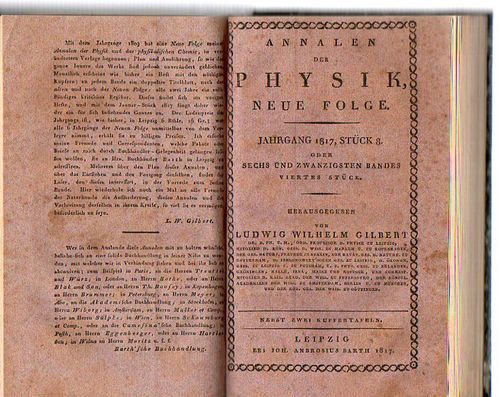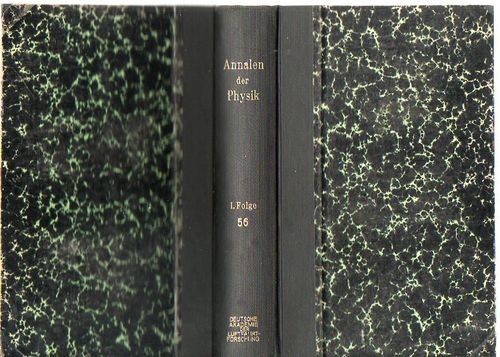Joseph Fraunhofer. Three papers: one revolutionary, one significant, and one interesting. Offered in three volumes of the Annalen der Physik, uniformly bound. [Sold]
“Bestimmung des Brechungs-und des Farbenzerstreungs-Vermögens verschiedener Glasarten, in Bezug auf die Vervollkommung achromatischer Fernröhre." Annalen der Physik I. 56, 1817. pp. 264-313. Black cloth; dark marbled boards with cloth tips. Offered in the volume I.56, sections 5-8, 440pp, 5 folding plates (folding in half, only), with (plates II, IV and V detached but present, vol IV having the Fraunhofer lines. Ex-libris Deutsche Akademie der Luftfahrtforschung, then Wright Patterson Field Library (USAF), then Library of Congress. Library markings: small gilt-stamped "Akademie der Luftfahrtforschung", page edges stamped "Wright Field LIbrary/Dayton, Ohio" on top and bottom. Printing and the Mind of Man 278a and Dibner, Heralds of Science, 153
Each issue bound with the very scarce, original (pinkish) printed outer wrappers. Very unusual so.
with:
(Fraunhofer) "Einige wissenschastliche Nachrichten aus Muenchen, aus einem Briefe des Dr. Chladni. (Ueber Fraunhofer's Licht-Verscuhs, vom Soemmerrings Veredlung des Weins, einem sehr seinem nemen Gespinnst und einer neuen Art Camer lucida)" In: Annalen der Physik, I. 51, pp 98-103. 430pp. Ex-libris Deutsche Akademie der Luftfahrtforschung, then Wright PAtterson Field Library (USAF), then Library of Congress. Library markings: small gilt-stamped "Akademie der Luftfahrtforschung", page edges stamped "Wright Field LIbrary/Dayton, Ohio" on top and bottom.
and with:
Fraunhofer, Joseph. "Kurzer Bericht von den Resultaten neuerer Versuche, ueber die Gesetzes des Lichtes, und die Theorie derselben." In: Annalen der Physik, I.74, 1823, part 8. Pp 337-378. ENtire volume offered, 440pp, 4 plates. Ex-libris Deutsche Akademie der Luftfahrtforschung, then Wright PAtterson Field Library (USAF), then Library of Congress. Library markings: small gilt-stamped "Akademie der Luftfahrtforschung", page edges stamped "Wright Field LIbrary/Dayton, Ohio" on top and bottom. "In the paper in 1823, Fraunhofer revealed his continued investigation of diffraction gratings. Using a diamont point, he could rule up to 3,200 lines per Parish inch. He continued his study of the effect of oblique reays, developed formulations based on the wave conception, and calculated a revised set of wavelenghts for the major spectral lines. Thus, his earlier observations of the dark lines in the solar spectrum enabled him to make the highly precise measurements of dispersions; then his ude of the wave theory of light allowed him to derive, with suitable simplifications, the general formulation of the grating equation still in use today." (Reese V. Jenkins in DSB).
"In the paper in 1823, Fraunhofer revealed his continued investigation of diffraction gratings. Using a diamont point, he could rule up to 3,200 lines per Parish inch. He continued his study of the effect of oblique reays, developed formulations based on the wave conception, and calculated a revised set of wavelenghts for the major spectral lines. Thus, his earlier observations of the dark lines in the solar spectrum enabled him to make the highly precise measurements of dispersions; then his ude of the wave theory of light allowed him to derive, with suitable simplifications, the general formulation of the grating equation still in use today." (Reese V. Jenkins in DSB).





Comments